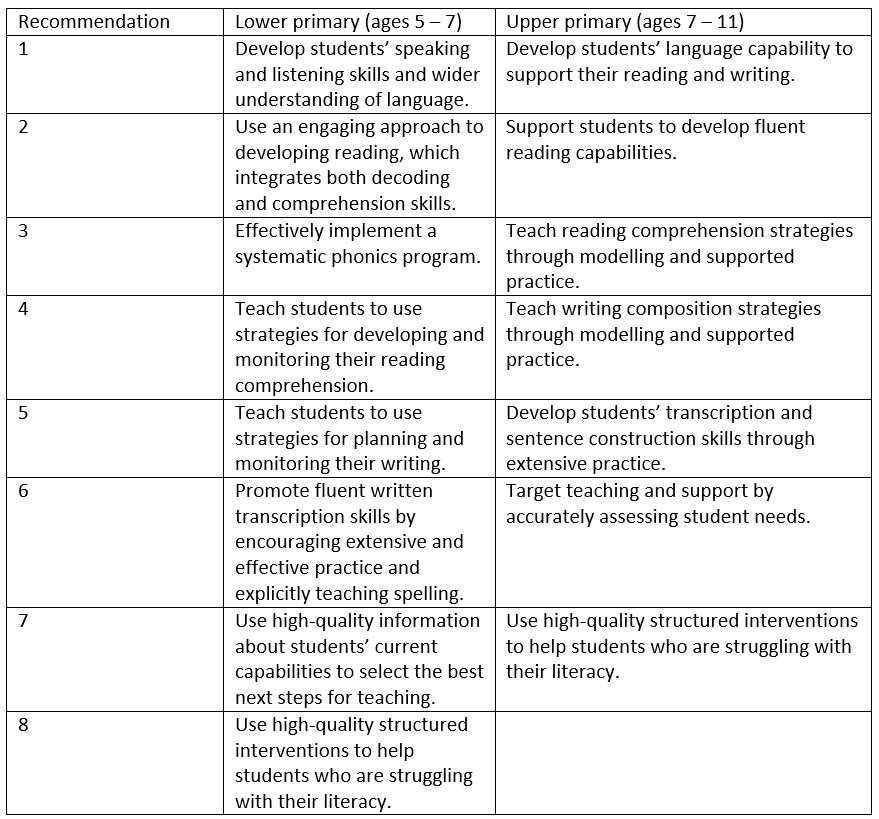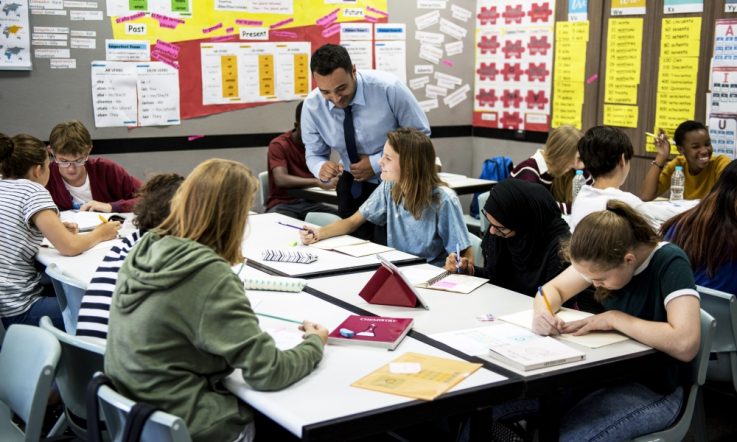Literacy is a core set of skills that can help students overcome social and economic barriers and underpin success in everyday life. Among other benefits, building a strong foundation in these skills in primary school has the potential to develop a lifelong love of reading.
There is a considerable amount of high quality evidence on what can have the greatest impact on literacy learning (Education Endowment Foundation, 2020a).
Two new literacy guidance reports
Evidence for Learning has recently published two literacy Guidance Reports focused on lower (Evidence for Learning, 2020a) and upper primary (Evidence for Learning, 2020b). Both of these Guidance Reports outline recommendations for the development of good literacy skills. The recommendations from each of the reports are outlined in Table 1. Common across these Guidance Reports is a focus on developing language, reading comprehension and writing skills. Accurate assessment of students' current skills and the provision of high quality interventions can help to ensure that students make the best possible progress in their literacy outcomes.

Table 1: Recommendations in the lower and upper primary Guidance Reports
Applying these recommendations during a crisis
Disruptions to normal schooling have plagued 2020. The COVID-19 pandemic is predicted to increase the achievement gap between students from disadvantaged backgrounds in comparison to those from advantaged backgrounds (Sonnemann & Goss, 2020).
This widening of the gap is projected to vary, depending on the amount of time students have spent in home-supported learning, with an average increased gap of five to seven weeks across literacy and numeracy for Australian students in Year 5. Logically, the longer the schools are in remote learning mode the wider the predicted gap with 6.6 weeks' loss for nine weeks of home-supported learning (Sonnemann & Goss, 2020).
This will not be the case for every school supporting students from disadvantaged areas, as there are promising directions and outcomes being reported – for example, Michael Rosenbrock's recent Teacher article on lockdown learning at Wodonga Senior Secondary College (Rosenbrock, 2020).
Considering the current situation nationally and globally in response to the COVID-19 pandemic, here we focus on how to gather and use high quality information on students' current achievements in literacy and the use of appropriate interventions.
Selecting the best next steps for teaching
High-quality information about students' current capabilities is gathered through assessment and diagnosis of needs, to be used to target and adapt teaching (Evidence for Learning, 2020a, 2020b). Using a current assessment of students' skills is more efficient as the ‘effort is spent on the best next step and not wasted by rehearsing skills or content that a child already knows well' (Evidence for Learning, 2020a, p.7). In response to the assessment of the students' needs, the teacher can:
- Provide rapid provision of support as directed by professional judgement.
- Change the approach that they are using if a student is disengaged or is finding activities too easy or too hard, adopt a different approach to teaching the same aspect of literacy.
- Adapt their teaching by selecting the particular aspect of literacy to focus on next (Evidence for Learning, 2020a, 2020b).
Catch up interventions
The Guidance Reports advise that matching the current needs of your school and students with the appropriate catch up intervention is crucial. For example, if currently the students are not reading enough, then the approach that is implemented needs to be designed to increase the amount that students' read (Evidence for Learning, 2020b). If you are trialling an intervention in your school that has not been rigorously evaluated, then there are certain features that are required:
- brief (15-45 minutes) and regular (3–5 times per week) sessions that are maintained over a sustained period (8–20 weeks) and carefully timetabled to enable consistent delivery;
- extensive training (5–30 hours) from experienced trainers or teachers for those implementing the intervention;
- structured supporting resources and/or lesson plans with clear objectives;
- assessments to identify appropriate students, guide areas for focus, and track student progress;
- tuition that is additional to, and explicitly linked with, normal lessons; and,
- connections between the out-of-class (intervention) learning and classroom teaching (Education Endowment Foundation, 2020b; Evidence for Learning, 2019, 2020a, 2020b; Slavin et al., 2011).
Conclusion
The importance of supporting students in their development of strong literacy skills is essential, especially for helping to overcome the additional barriers that can be in place for those surrounded by disadvantage.
A focus on understanding the individual needs of the student and acting in response to this – through using teacher professional judgement and adaption of the focus and teaching approaches – can improve students' literacy skills.
If catch up interventions are required, they need to be thoughtfully implemented with a focus on dosage, training, provision of supporting resources, and tuition.
Readers who would like to find out more about evidence-based literacy strategies for primary students can register for a free webinar hosted by Evidence for Learning on Tuesday 21 July.
References
Education Endowment Foundation. (2020a). Evidence for Learning Early Childhood Education Toolkit: Education Endowment Foundation. https://www.evidenceforlearning.org.au/the-toolkits/the-teaching-and-learning-toolkit
Education Endowment Foundation. (2020b). Evidence for Learning Early Childhood Education Toolkit: Education Endowment Foundation. One to one tuition. https://www.evidenceforlearning.org.au/the-toolkits/the-teaching-and-learning-toolkit/all-approaches/one-to-one-tuition/
Evidence for Learning. (2019). Making best use of Teaching Assistants. https://www.evidenceforlearning.org.au/assets/Guidance-Reports/Teaching-Assistants/E4L-Guidance-Report-Teaching-Assistants-Sep-WEB.pdf
Evidence for Learning. (2020a). Improving literacy in lower primary. Evidence for Learning. https://evidenceforlearning.org.au/guidance-reports/improving-literacy-in-lower-primary-school/
Evidence for Learning. (2020b). Improving literacy in upper primary. Evidence for Learning. https://evidenceforlearning.org.au/guidance-reports/improving-literacy-in-upper-primary
Rosenbrock, M. (2020, June 18). Learning in lockdown – rural schools. Teacher magazine. https://www.teachermagazine.com/articles/learning-in-lockdown-rural-schools
Slavin, R. E., Lake, C., Davis, S., & Madden, N. A. (2011). Effective programs for struggling readers: A best-evidence synthesis. Educational Research Review, 6(1), 1-26.
Sonnemann, J. & Goss, P. (2020).COVID catch-up: helping disadvantaged students close the equity gap. Grattan Institute.
How are you planning to assess your students’ learning in literacy to determine what are the best next steps for teaching?
What evidence do you have to support that the catch up intervention that you are using, or planning to use, at your school has the potential to improve students’ learning?



